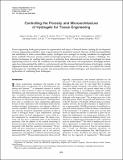| dc.contributor.author | Annabi, Nasim | |
| dc.contributor.author | Nichol, Jason W. | |
| dc.contributor.author | Zong, Xia | |
| dc.contributor.author | Ji, Chengdong | |
| dc.contributor.author | Koshy, Sandeep Tharian | |
| dc.contributor.author | Khademhosseini, Ali | |
| dc.contributor.author | Dehghani, Fariba | |
| dc.date.accessioned | 2011-03-11T15:56:53Z | |
| dc.date.available | 2011-03-11T15:56:53Z | |
| dc.date.issued | 2010-03 | |
| dc.date.submitted | 2009-09 | |
| dc.identifier.issn | 1937-3368 | |
| dc.identifier.uri | http://hdl.handle.net/1721.1/61669 | |
| dc.description.abstract | Tissue engineering holds great promise for regeneration and repair of diseased tissues, making the development of tissue engineering scaffolds a topic of great interest in biomedical research. Because of their biocompatibility and similarities to native extracellular matrix, hydrogels have emerged as leading candidates for engineered tissue scaffolds. However, precise control of hydrogel properties, such as porosity, remains a challenge. Traditional techniques for creating bulk porosity in polymers have demonstrated success in hydrogels for tissue engineering; however, often the conditions are incompatible with direct cell encapsulation. Emerging technologies have demonstrated the ability to control porosity and the microarchitectural features in hydrogels, creating engineered tissues with structure and function similar to native tissues. In this review, we explore the various technologies for controlling the porosity and microarchitecture within hydrogels, and demonstrate successful applications of combining these techniques. | en_US |
| dc.description.sponsorship | National Institutes of Health (U.S) (HL092836) | en_US |
| dc.description.sponsorship | National Institutes of Health (U.S) (EB009196) | en_US |
| dc.description.sponsorship | National Institutes of Health (U.S) (DE019024) | en_US |
| dc.description.sponsorship | National Science Foundation (U.S.) | en_US |
| dc.description.sponsorship | Australian Research Council (Grant No. DP0988545) | en_US |
| dc.language.iso | en_US | |
| dc.publisher | Mary Ann Liebert, Inc. | en_US |
| dc.relation.isversionof | http://dx.doi.org/10.1089/ten.teb.2009.0639 | en_US |
| dc.rights | Article is made available in accordance with the publisher's policy and may be subject to US copyright law. Please refer to the publisher's site for terms of use. | en_US |
| dc.source | Mary Ann Liebert | en_US |
| dc.title | Controlling the Porosity and Microarchitecture of Hydrogels for Tissue Engineering | en_US |
| dc.type | Article | en_US |
| dc.identifier.citation | Annabi, Nasim et al. “Controlling the Porosity and Microarchitecture of Hydrogels for Tissue Engineering.” Tissue Engineering Part B: Reviews 16.4 (2011): 371-383. copyright 2011 Mary Ann Liebert, Inc. | en_US |
| dc.contributor.department | Harvard University--MIT Division of Health Sciences and Technology | en_US |
| dc.contributor.approver | Khademhosseini, Ali | |
| dc.contributor.mitauthor | Nichol, Jason W. | |
| dc.contributor.mitauthor | Koshy, Sandeep Tharian | |
| dc.contributor.mitauthor | Khademhosseini, Ali | |
| dc.relation.journal | Tissue Engineering. Part B | en_US |
| dc.eprint.version | Final published version | en_US |
| dc.type.uri | http://purl.org/eprint/type/JournalArticle | en_US |
| eprint.status | http://purl.org/eprint/status/PeerReviewed | en_US |
| dspace.orderedauthors | Annabi, Nasim; Nichol, Jason W.; Zhong, Xia; Ji, Chengdong; Koshy, Sandeep; Khademhosseini, Ali; Dehghani, Fariba | en |
| dc.identifier.orcid | https://orcid.org/0000-0003-2836-5813 | |
| mit.license | PUBLISHER_POLICY | en_US |
| mit.metadata.status | Complete | |
